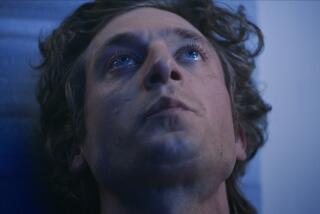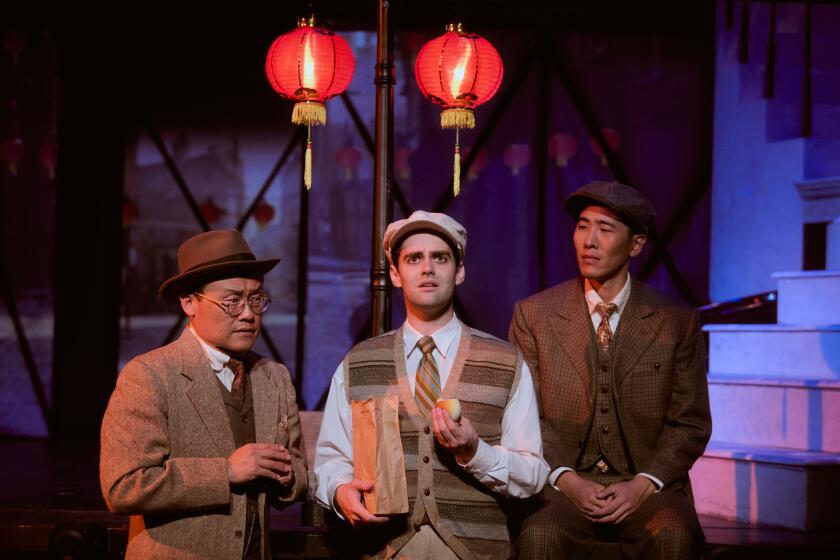ART REVIEW : FROM THE STREET TO THE STUDIO
One stalks his prey, surreptitiously tracking it for hours or hiding on a balcony before attacking at a moment of vulnerability. The other fusses around in a studio or outdoor location, rigging up tableaux, directing actors or fabricating objects before shooting.
These two modes of working--catching pictures on the fly or artfully contriving them--represent opposite poles of photography.
The philosophical difference between the extremes can’t be measured in the distance between San Diego and La Jolla, but anyone willing to make the 20-minute drive between the Museum of Photographic Arts in Balboa Park and the La Jolla Museum of Contemporary Art can instantly see the gulf between the street folks and the hip directors.
The Museum of Photographic Arts currently champions “Masters of the Street,” with photos by Andre Kertesz, Helen Levitt, William Klein and Lisette Model in Part II of a continuing series on street photography, through Oct. 13. The La Jolla Museum of Contemporary Art temporarily takes an opposing stance by presenting “Recent Work, No Fancy Titles,” pairing photographs of setup subjects by Eileen Cowin and John Divola, through Oct. 6.
Of the two shows, “Masters of the Street” is the crowd pleaser, displaying a large group of easily understood pictures that march under the banner of a hallowed tradition. A crisp black-and-white installation of mostly black-and-white pictures is itself a sort of street scene, complete with wrought-iron park benches, street lamps and potted trees.
The decor lends the look of a French period piece, appropriate to many of the photos. For every frenzied view of contemporary humanity, there is a fond remembrance of Paris of the ‘20s or a confrontation with some lumpy old character wedded to a chair on Nice’s Promenande des Anglais.
The artists represented are indeed masters of the genre, though only Kertesz--the actual father of Cartier-Bresson’s “decisive moment”--is widely known in Southern California. Though they all work on the street, they veer off in all directions.
Model isolates great mounds of flesh or twisted human relics in portraits as relentlessly probing as those of Diane Arbus. Human form and expression are all to Model; setting is merely a necessary backdrop as she forces her camera into jowly faces and inflated bellies. She makes us cringe, but not at the freakishness of humanity. What grabs the gut is our recognition of the forces that turn ordinary people into craggy rocks, gnarled trolls and blind beggars.
Klein is also confrontational, but he’s inclined to examine anxious relationships and the stresses of social situations. Known for capitalizing on photography’s faults--its graininess, blurriness and accidental effects--Klein makes pictures that have the immediacy of grab-shots. His camera is like a popgun, and his pictures crackle and spit as he blasts away at highly charged, disorganized situations. Whether he throws a film frame around a family picnic in Rome or a kid pulling a face as he sits in the lap of a Buddha sculpture, Klein’s stance is that of an intruder in the house of chaos.
Levitt and Kertesz have gentler sensibilities, though Levitt has made her artistic home in rough neighborhoods. Most often, she turns her camera on children and accomplishes the difficult feat of exposing their purity, sweetness, feistiness and nastiness without cloying or judging. In pictures made primarily in New York in the ‘40s, she catches a little boy lifting a girl’s skirt, kids rousting about in rubble and a couple of men taking their ease amid a mass of sewing machines and refrigerators. The city melting pot is cracked and its contents are polluted, but people swimming in the brew seem to survive, even thrive in it.
Kertesz tends to stand alone in present company because he stands back gracefully. Instead of peering rudely into people’s lives, the better to expose their frailties, he focuses on the rhythmic flow of their movement and the surreal wit of their urban arrangements, often from a bird’s-eye vantage point.
People are the forces behind circular paths in snow or under a row of umbrellas in a rainy street, but we only witness them as tiny dancers in a marvelously choreographed production or as punctuation points in a harmonious composition. His people don’t struggle against their environment; they are thoroughly absorbed in its lines and textures.
For all the affrontery of the boldest photographers working in this genre, street photography sustains an aura of populist morality. Here is truth told by just plain folks, and we draw comfort from its familiarity. The only trouble with that assessment is that there are so many truths, so variously interpreted. If that weren’t so, if the pictures weren’t filtered through an artist’s sensibility, they wouldn’t be art; they would be photojournalism.
Cowin’s and Divola’s work at La Jolla buries the notion of simple photographic truth in a morass of conceptual issues. Both artists make laboriously contrived pictures that need elaborate explanations. Beyond that link, they have little in common. Cowin even seems to be drifting away from a stilted, theoretical vein and toward relative naturalness. Her recent docudramas continue a practice of using friends and family members as actors. Though her large prints look rather like stills from soap operas, they are less brazenly theatrical and more involving than earlier examples. And her move from glossy color to black and white seems to remove another barrier for viewers.
We don’t for a minute think that Cowin has photographed these bedside and breakfast table dramas as they really happened, but she no longer hangs us up on a scene’s falseness. Quickly grasping the elements and actors in each equivocal narrative, we get on with imagining what went on before and what might follow. The figures become types or symbols for age groups rather than individuals and we see them in that larger context. Fuzzy characters read as dream subjects of more sharply focused people. Particularly effective close-ups of a whisper, a kiss or a hand on a shoulder infuse simple gestures with surprising emotional resonance.
While Cowin seems to be emerging from the conceptual woods with pictures that can be felt as well as reasoned, Divola appears to have moved deeper into the thicket. Always an interesting photographer and often a compelling one, he now produces color pictures whose visual and emotional qualities are subservient to the ideas behind them. Unfortunately, this show catches him at a time when he’s in a muddle, trying a lot of conflicting approaches.
He impresses us with the cleverness of his dialogue between art and nature by, say, setting up an abstract cardboard sculpture on a seaside cliff and balancing little rock sculptures on boulders. It’s cute, but it’s hard to care about such an exercise. The same is true of a primitive house and a ragged cone flooded with colored light in a clearing. When he tips horizons and superimposes geometric shapes on landscapes, Divola speaks in codes to other photographers.
The images that have the best chance of reaching beyond photography’s in-group are those involving silhouettes of figures and animals. Here Divola uses preconceived notions about snarling dogs, shadowy burglars and falling figures to charge images with psychological power.
This pair of exhibitions unleashes possibilities for endless comparisons and philosophical clashes. Most of them dissolve in the dawning realization that both ways of working are well established traditions and that they feed on each other. What finally counts is the individual picture that distills perception and experience so effectively that it constitutes a new encounter.
More to Read
The biggest entertainment stories
Get our big stories about Hollywood, film, television, music, arts, culture and more right in your inbox as soon as they publish.
You may occasionally receive promotional content from the Los Angeles Times.






